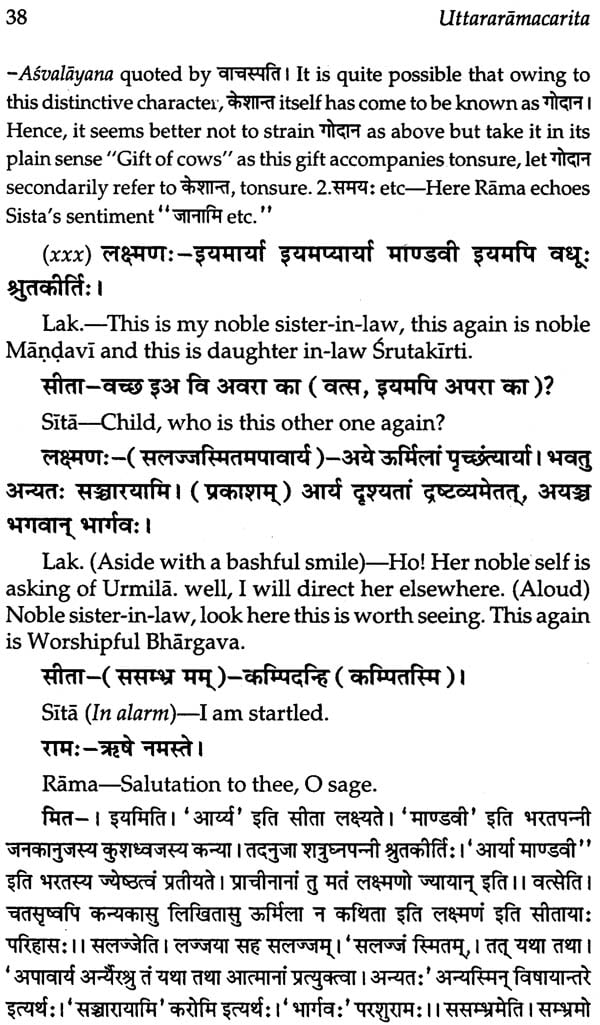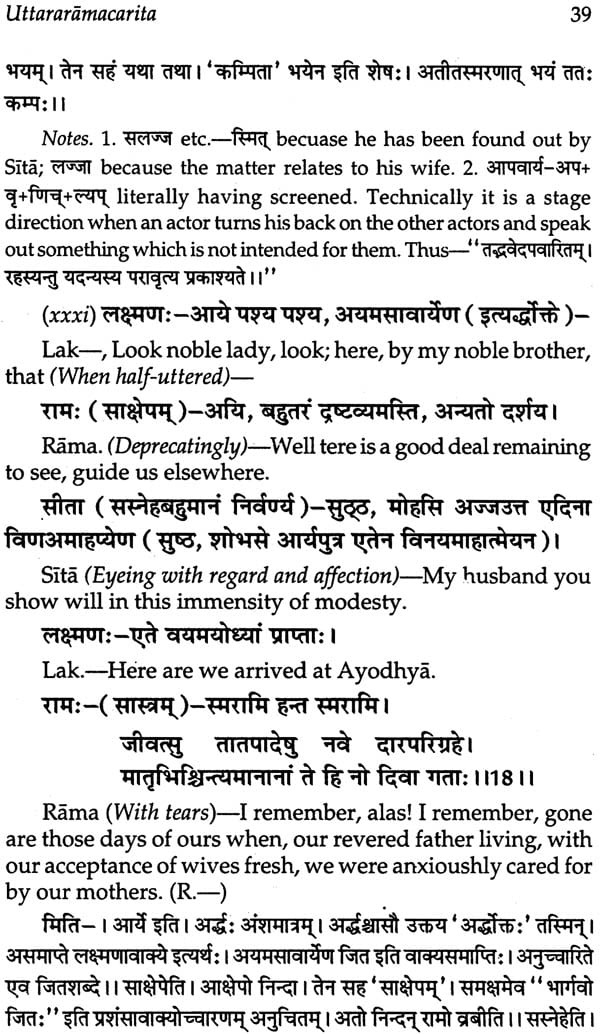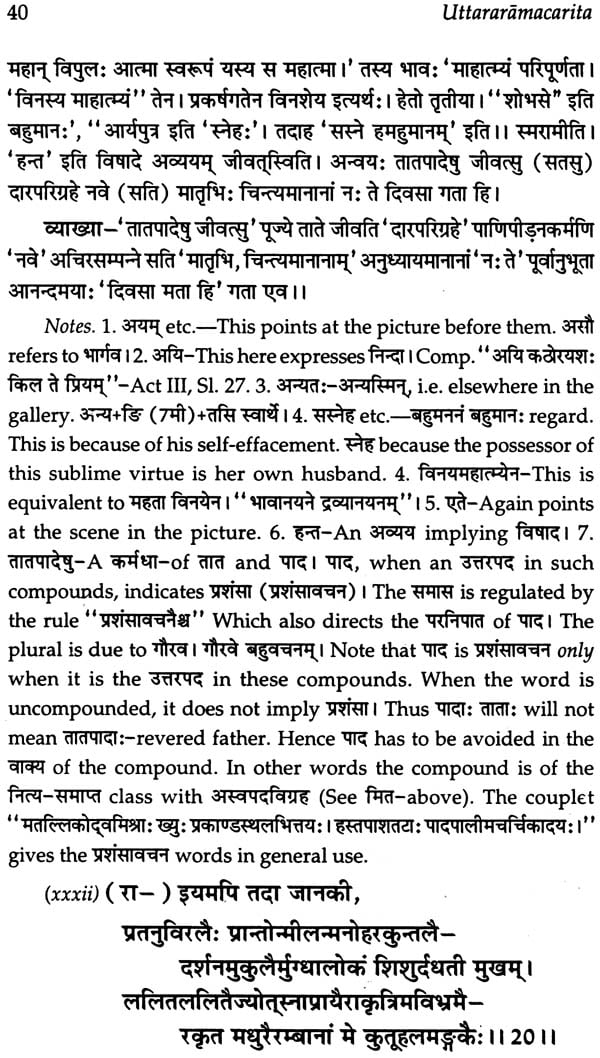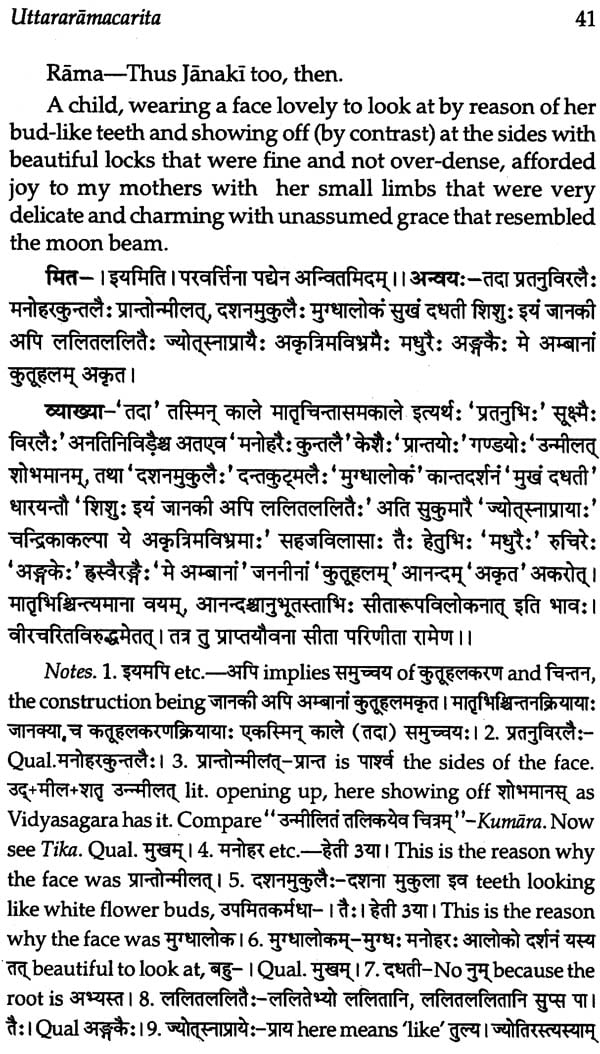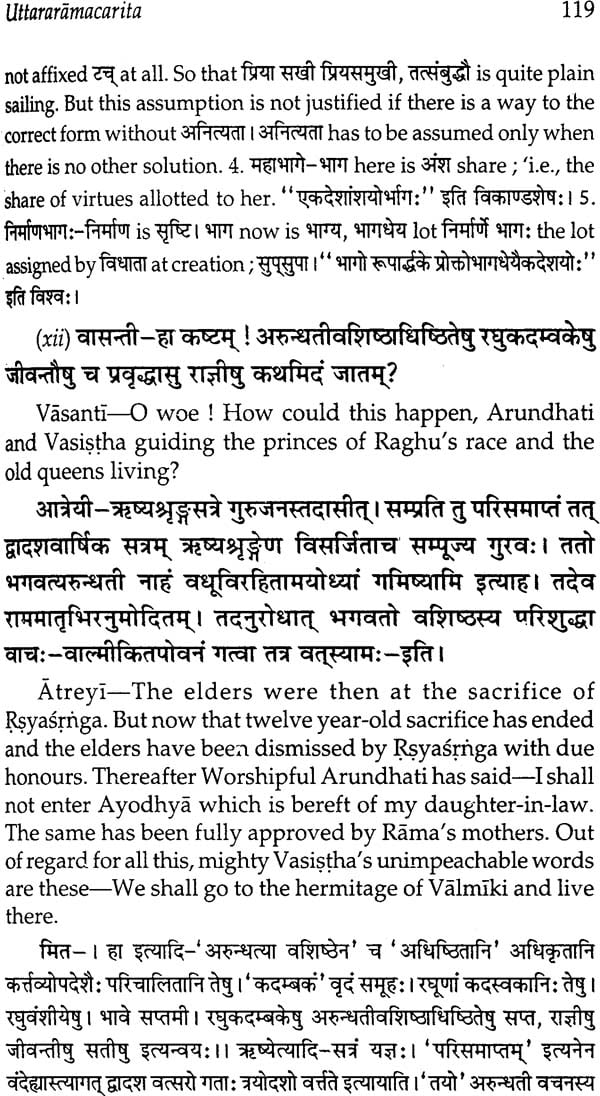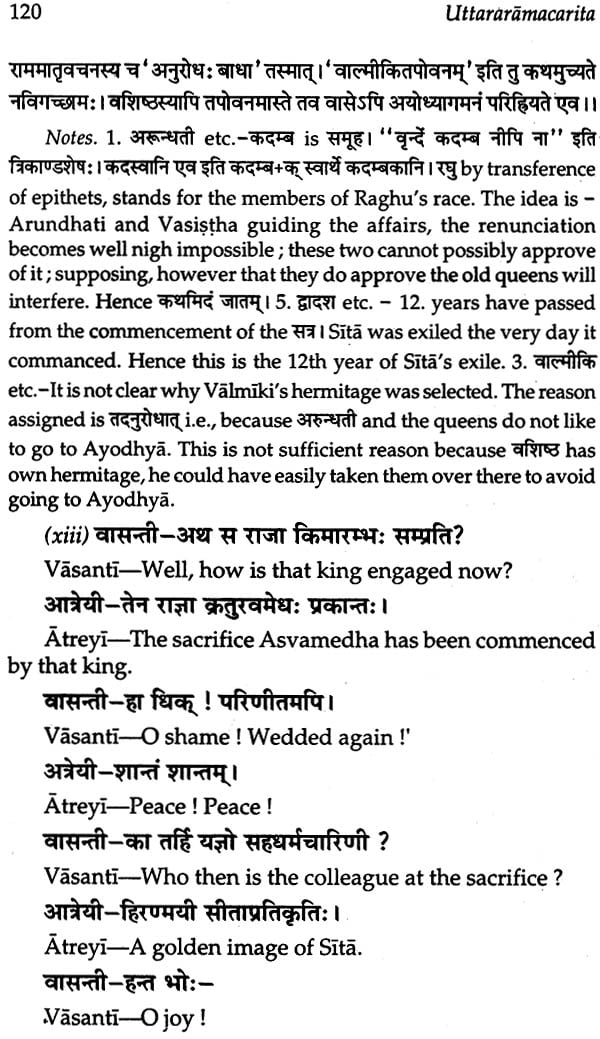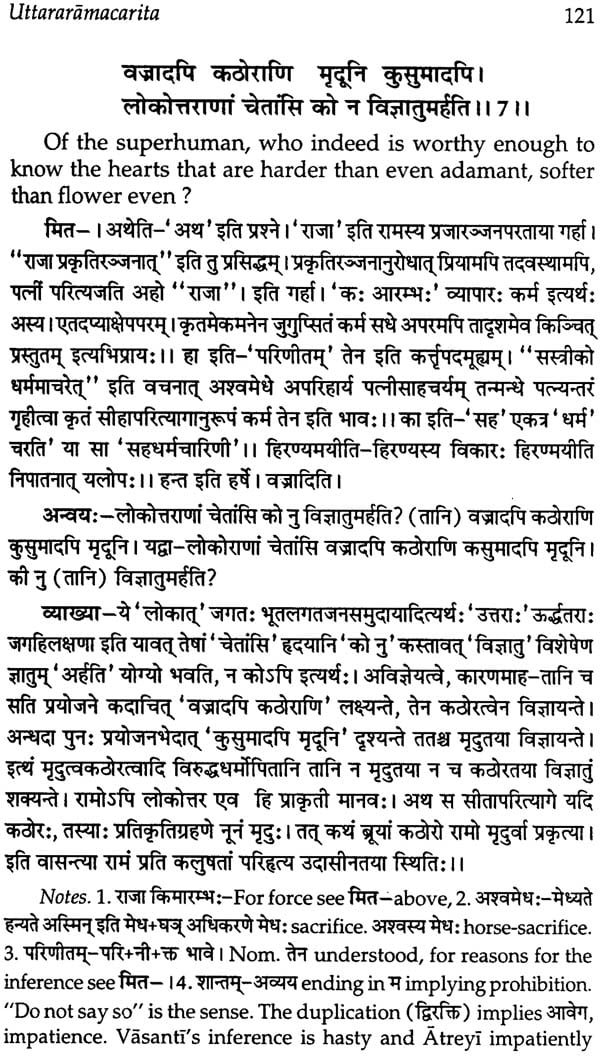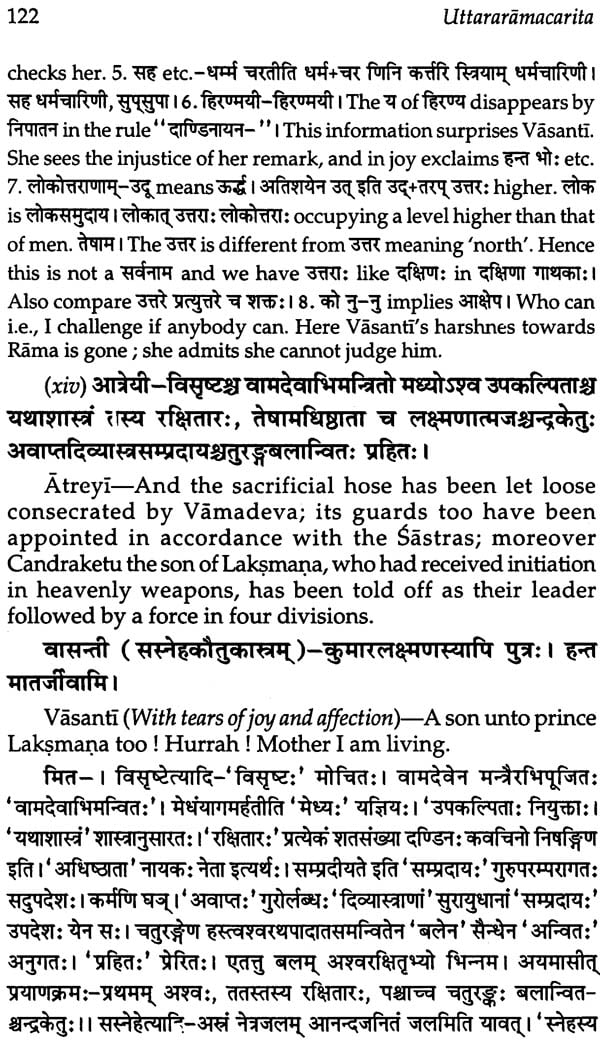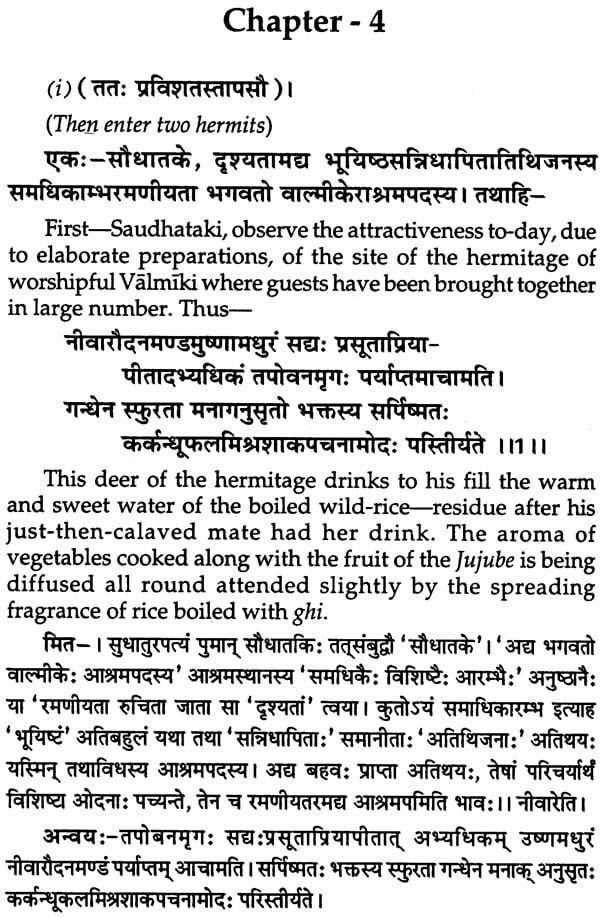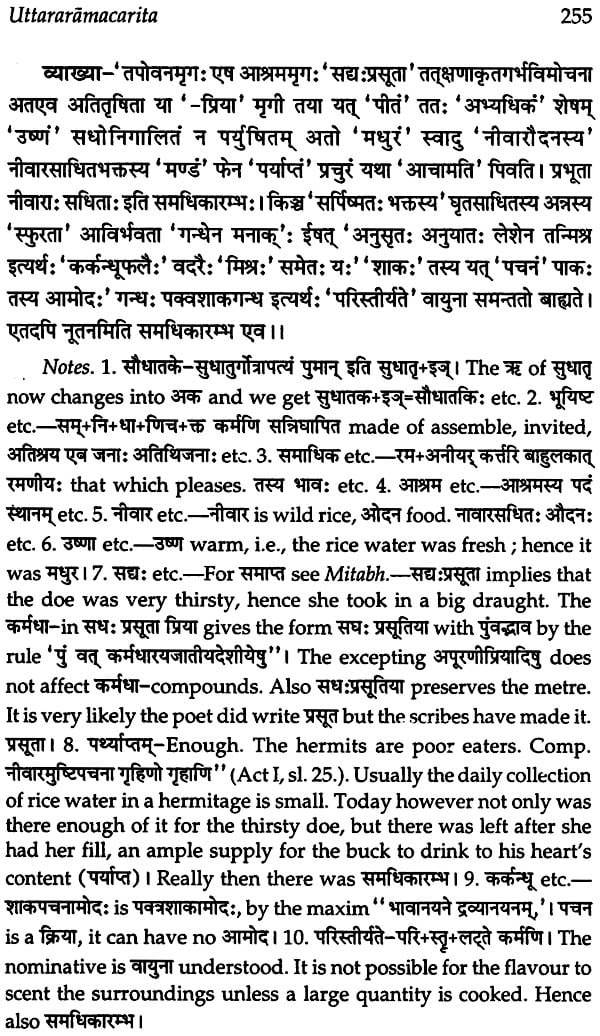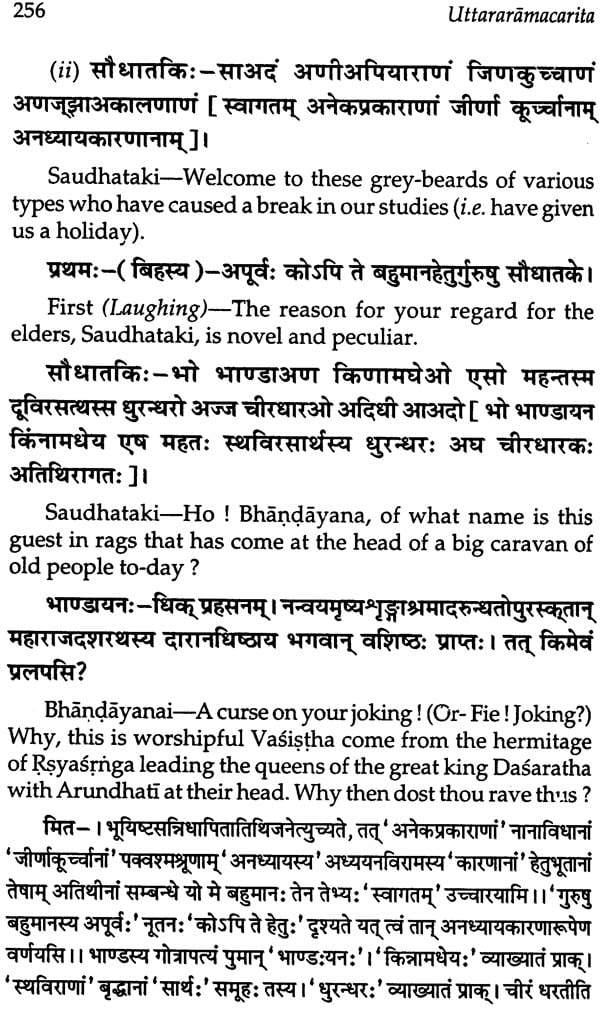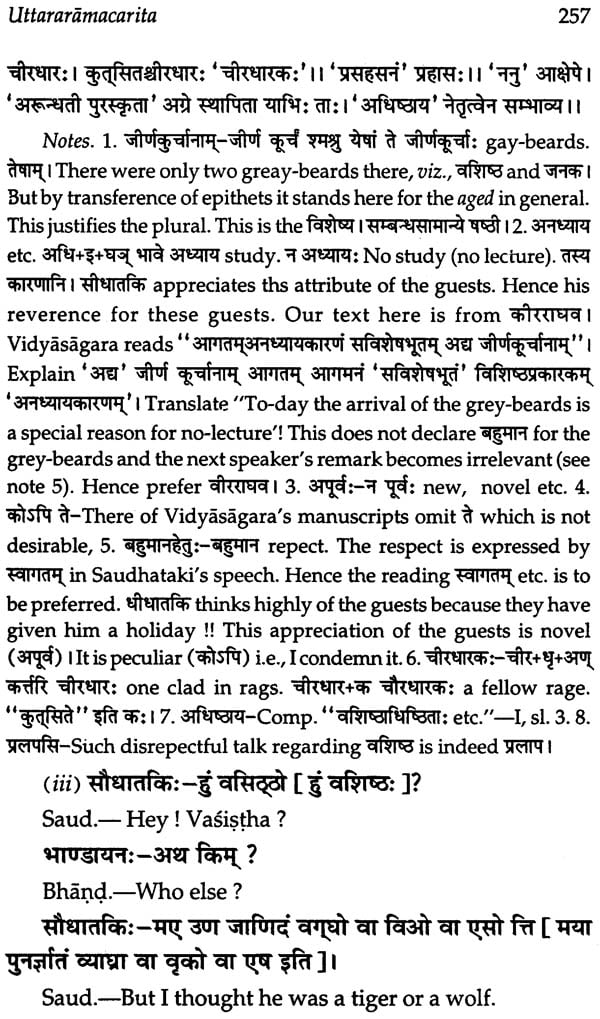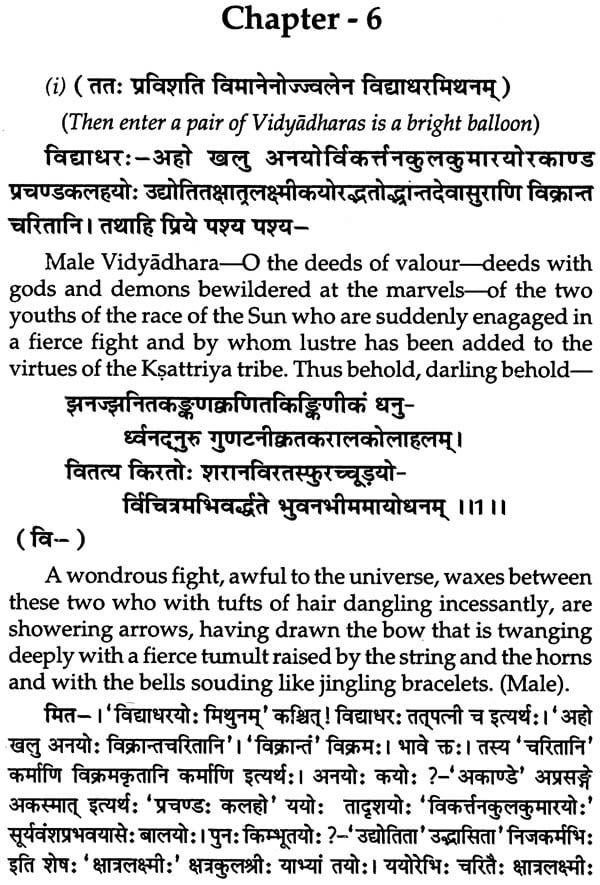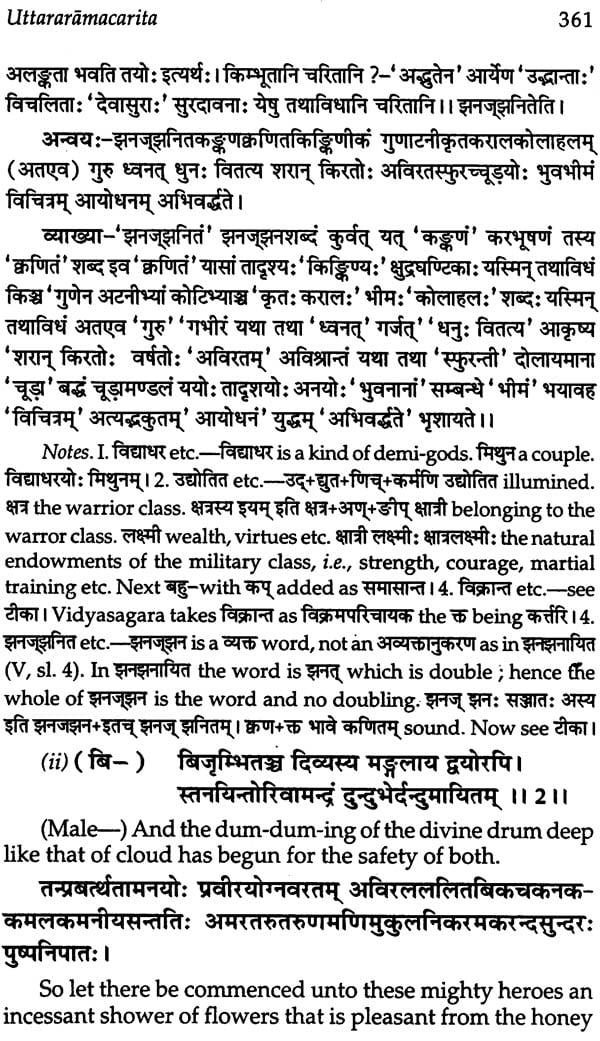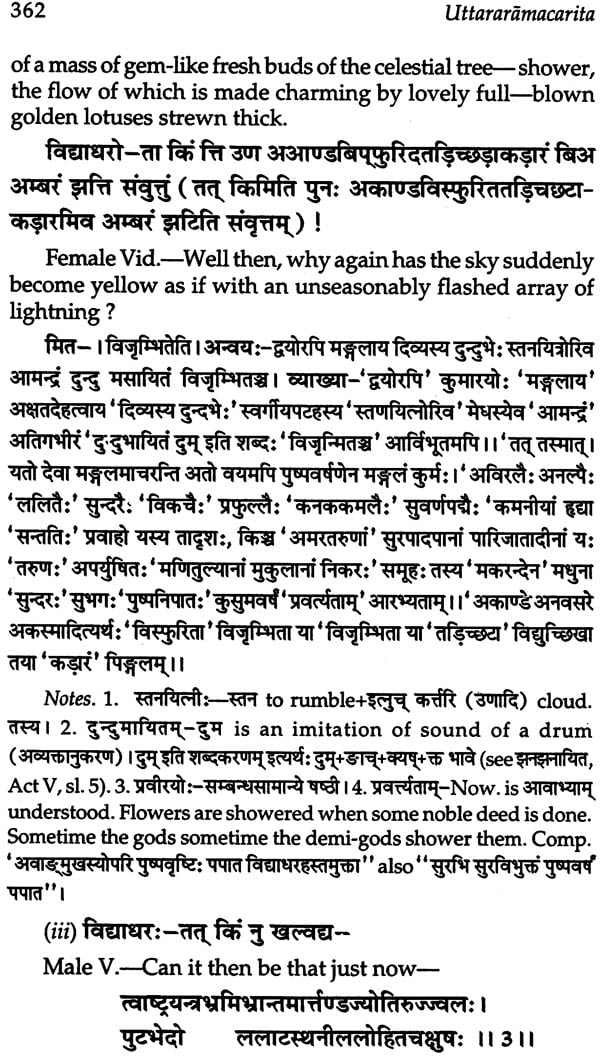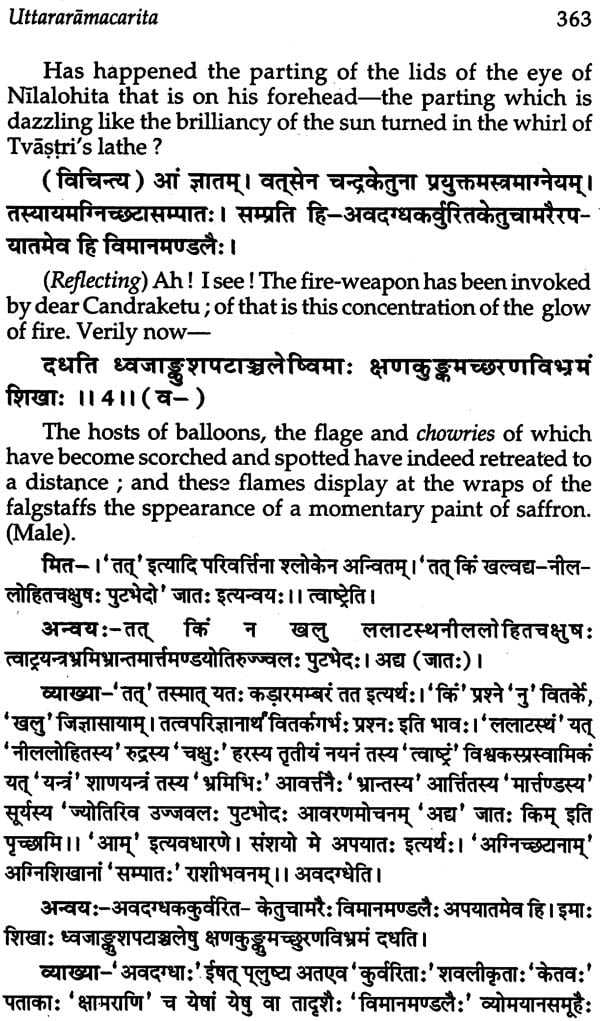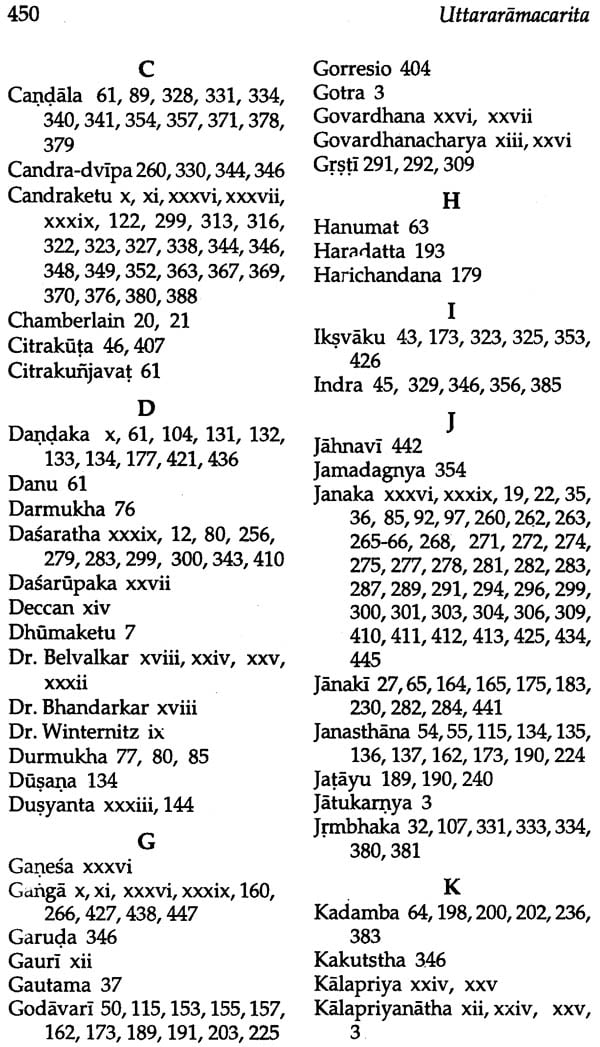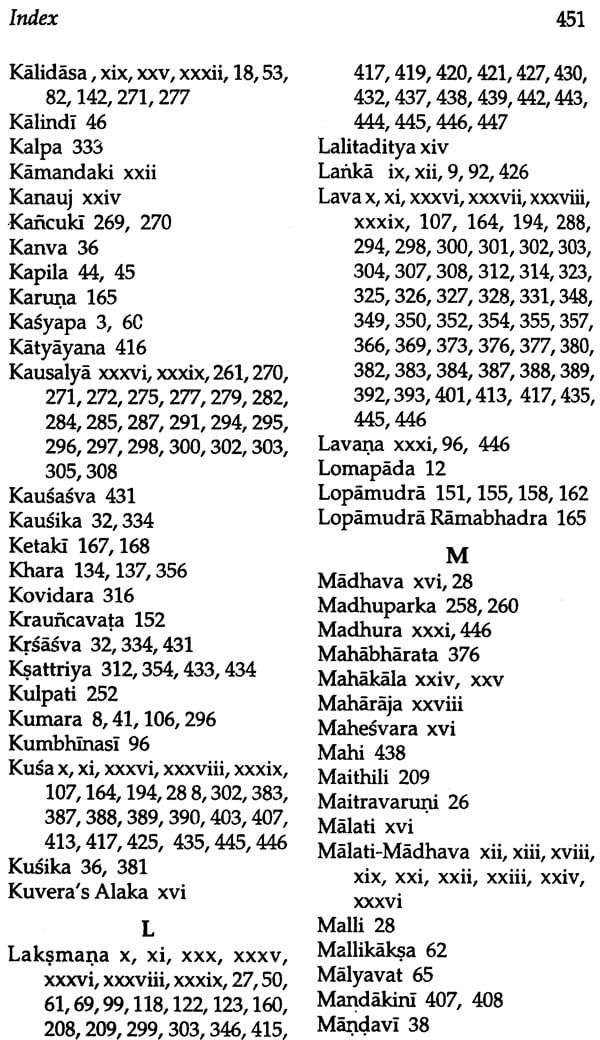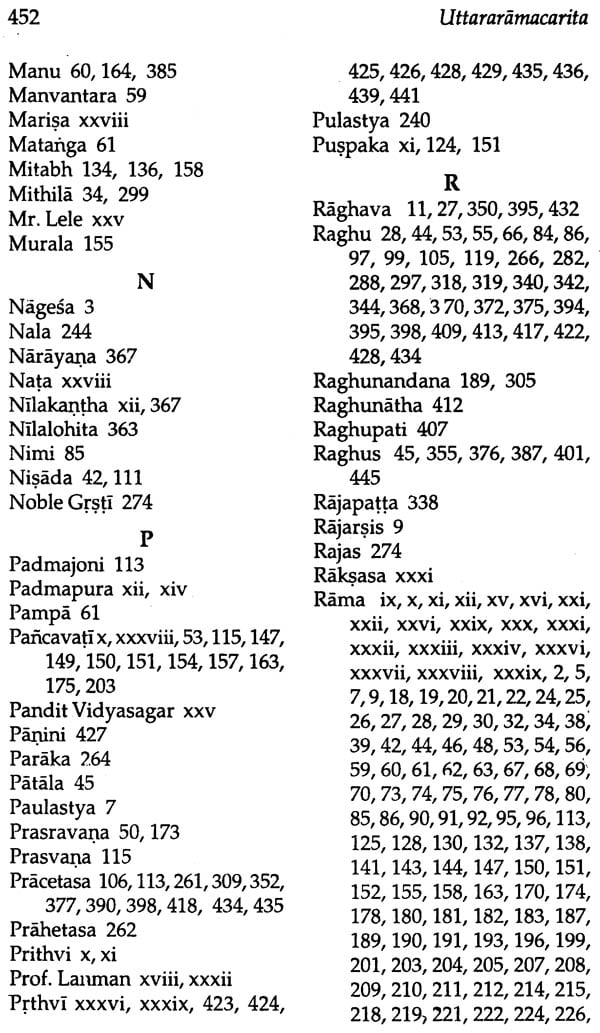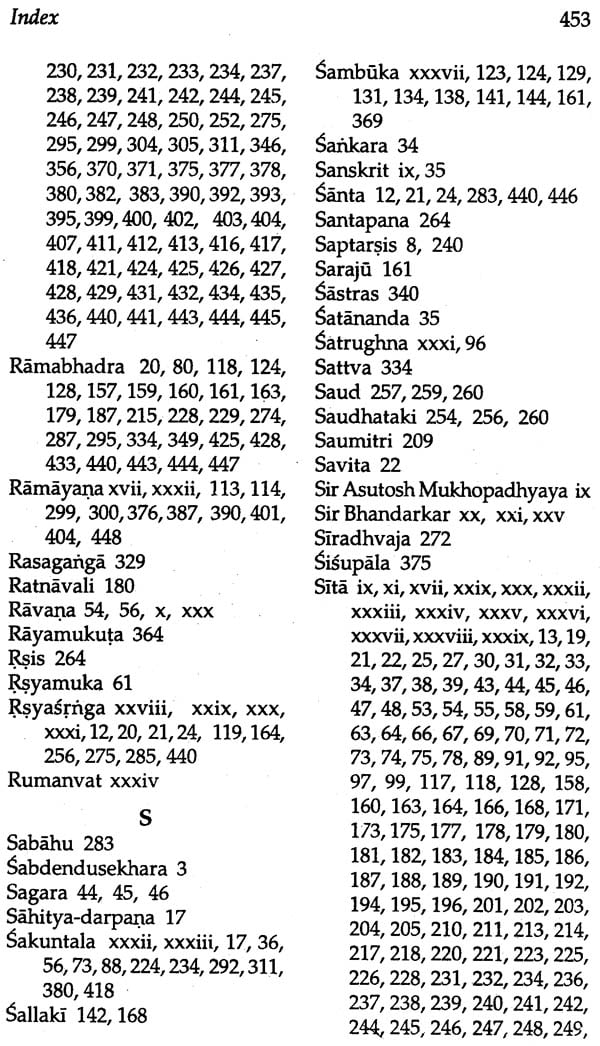
Bavabhuti’s Uttaramacaritam (With Sanskrit Commentary, English Translation, Critical and Explanatory Notes)
Book Specification
| Item Code: | NAJ236 |
| Author: | Saradaranjan Roy |
| Publisher: | Bharatiya Kala Prakashan |
| Language: | Sanskrit Text with English Translation |
| Edition: | 2008 |
| ISBN: | 9788180901911 |
| Pages: | 495 |
| Cover: | Hardcover |
| Other Details | 8.5 inch X 5.5 inch |
| Weight | 700 gm |
Book Description
About the Book
This book is about the later history of Rama which starts with his coronation after returning from Lanka. The book is divided in seven parts. Every part tells a story such as how people commence talking recklessly of Sita with reference to her stay in Lanka. How Rama commences Asvamedha sacrifice, how the sacrificial horse wanders into Valmiki’s hermitage and is seized by Lava, how Laksmana’s son, Candraketu, meets Lava, and their battle, how Rama notices the battle from Puspaka, and how Valmiki comes to the rescue of the bewildered monarch. In short, the book explains every sloka with English translation and explanatory notes, thus making the book very interesting to read.
Preface
In this volume the text is based mainly upon the late Pandit Vidyasagara’s edition, though occasionally. I have adopted readings from (i) Vidyasagara’s extracts from his four manuscripts, and (ii) the Bombay edition of Viraraghava.
While preparing the translation, I have derived much help from the late principal Tawney’s precious little book. I am sorry Dr. Belvalkar’s translation came in too late to be of much use in the earlier. Acts but it has saved me much trouble from the middle of Act V to the end.
The Commentary is my own. In its preparation I have often had occasion to consult Viraraghava, Vidyasagara, Goswami, etc. I have however, often ventured to differ from my predecessor. This has happened so often, that for sheer economy of space to keep down the price of the book, I do not say so (except in a few places) when I have a new explanation to offer. But I am sure the intelligent reader will be able to detect the omission at a glance.
For convenience of reference, the text has been divided into paragraphs. Where a paragraph end in the middle of a speech the initials of the speaker are given both at the end of the para and at the beginning of the next para.
My thanks are due to Pandit Kalikrishna Battacharya, Pandit Sudhakara Senior Professor of Sanskrit, Vidyasagara College, and to Professor Amujyacharan Vidyabhushana, Senior Professor of Pali, Vidyasagara College, for hunting up certain references for me.
I shall be much obliged if my readers will kindly draw my attention to errors and imperfection with a view to correction in the next edition.
This is a revised and meterially enlarged edition of our Uttararamacarit. Many notes and items are added here and there to make it more useful to its readers.
Introduction
N.B.-In the Summer of 1923, I read at the university institute an essay in Bengali on the "Fame of Bhavabhuti." The late lamented Sir Asutosh Mukhopadhyaya felt interested to such an extent that he wanted to forward, for an expression of opinion, a copy of the essay to Dr. Winternitz who then at Bolepur and he asked me to translate it into English, the translation was begun, but at its very commencement I was laid up for nearly two months with a serve attack of Pluerisy. The malady left me prostrate. As soon as I recovered a little I got Influenza and was down with it for nearly a month.
For these reasons I could not resume the work of translation during the life-time my honoured friend. Lately on taking up the work again I found reasons for extensive additions and alterations I have now, however, the melancholy satisfaction of having finished the task set me by the illustrious dead. The translation now appears as Introduction to this volume.
The Uttararamacarita-One of the most popular of sanskrit dramatists is Bhavabhuti, He is better knows and the author of the Uttararamacarita.
The Uttararamacarita is ususally considered by competent critics to be one of the best wrtten of Sanskrit dramas It is in seven Acts and is based on the later history of Rama commencing with his coronation after return from Lanka.
(i) The first Act tells us that soon after the coronation, people commence talking recklessly of Sita with reference to her stay in the house of Ravana. The new reaches Rama’s ears and the king banishes his queen.
(ii) The second act opens with incidents that happen after a lapse of twelve years.
Rama commences the Asvamedha sacrifice. While preparation are going on for the sacrifice he is obliged to go out personally in quest of a certain Sudra ascetic practising penance in the forest fo Dandaka. At the sight of the place old association wake up the thoroughly over whelm the king.
This Act and the Acts that follw describe events that take place within a day or two one another.
(iii) In the third Act we learn that Sita is still alive through practically dead to the world. Delivered of twins (named Kusa and Lava) on the day of her banishment she has been staying in the nether regions these twelve years with Prithvi and Ganga. The boys were made over to Valmiki by Ganga herself for their training and education.
Ganga knew that on his way back after meeting the Sudra ascetic, Rama would have to pass over the Panchavati the sight of which was bound to recall extremely painful memories. To relieve the shock she came over with Sita to meet Godavari. From there she sent Sita to gather flowers-a mere pretext-from the Panchavati making her invisible to morals.
As expected Rama enters the Panchvati, meets Sita there, feels her presence, but, being unable to see her, takes all this as a delusion, and with a heavy heart hastens towards his capital to get ready for the Asvamedha.
(iv) Here commences the fourth Act. The sacrifical horse wanders into Valmiki’s hermitage and is seized by Lava.
(v) In the fifth Act, Chandraketu, Laksmana’s son, the guardain of the horse, meets Lava and forthwith the boys are attracted towards each other and become friends. Lava, however, makes certain remarks regarding Rama and a regular fight follows.
(vi) The sixth act introduces Rama again who notices the battle from the Puspaka, his aerial car, while proceeding towards his capital, comes down and prohibits the fight. Lava is then introduced to Rama by Chandraketu. Next Kusa arrives and is introduced by Lava. Hovering between hope and despair, Rama notices the startling resemblance of the features of the boys with his own and those of Sita.
(vii) Forthwith, in the seventh Act, Valmiki comes to the rescue of the bewildered monarch. The sage invites the whole creation to witness the staging, by celestial nyhphs under the guidance of the sage Bharata, of a certain drama written by himself on the later history of Rama, Laksmana prepares a theatre and seats the audience. Rama himself is present at the performance.
The performances discloses that Sita was dilivered of twins on the very day of her exile and is still alive in Patala under the care of Prithvi and Bhagirathi, Her boys are with the sage Valmiki. All see that they are no other than Kusa and Lava.
The nymphs now retire, the acting ceases, and Valmiki appears personally. He arranges for a declaration of Sita’s innocence and at his command Sita herself emerges out of the waters of the Ganges led by Prthvi and Ganga. Arundhati now delivers a well-merited snub to the people of Ayodhya and the villages and asks Rama to take back his spouse. The whole creation joins in the request, the people stand abashed and re-union follows.
Contents
| Preface | (v) |
| Introduction | (ix) |
| Chapter 1 | 1 |
| Chapter 2 | 101 |
| Chapter 3 | 155 |
| Chapter 4 | 254 |
| Chapter 5 | 316 |
| Chapter 6 | 360 |
| Chapter 7 | 415 |
| Index | 449 |
